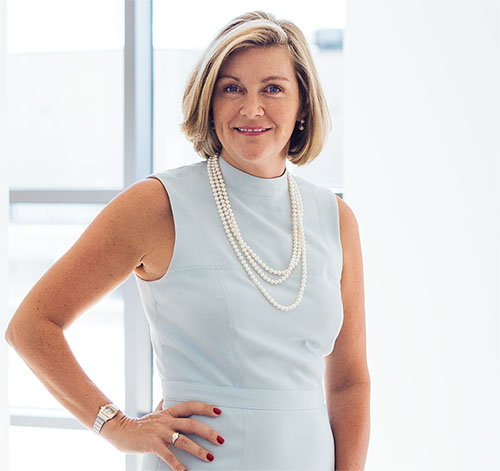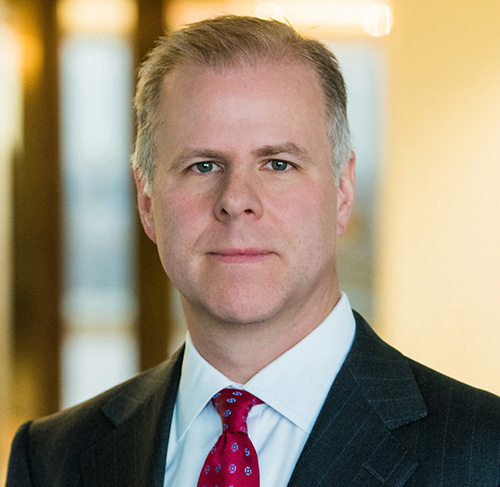Skadden partners Jennifer Bragg, James Carroll, Lisa Gilford and Graham Robinson.
In August, Gilead Sciences announced it was acquiring Kite Pharmaceuticals for $11.9B. The deal was noteworthy for its size and the fact that it came amid a decline in healthcare and life sciences deals that had settled in during the earlier part of 2017.
Lawdragon had the opportunity to talk to key players from Skadden’s healthcare and life sciences team, including partner Graham Robinson, who heads Boston’s Mergers and Acquisitions Group and represented Gilead in the deal; partner Jennifer Bragg, a regulatory and litigation specialist operating out of Washington, D.C. and former Associate Chief Counsel at the U.S. Food and Drug Administration; Boston office leader James Carroll, a litigator who has secured important wins for many healthcare and pharmaceutical clients in securities class actions, among other areas; and Los Angeles-based partner Lisa Gilford, an expert at defending consumer class actions, including for major pharmaceutical clients.
Healthcare and life sciences is a vibrant and ever-growing space that presents a range of issues and opportunities for companies as they navigate economic and policy challenges related to the delivery and accessibility of healthcare and life-saving medications. With a new administration vowing sweeping changes to the healthcare system and an aging population with persistently mounting healthcare costs — along with dazzling developments in technology that extend lives — there’s never been a more interesting time to be on the front lines of legal practice in this arena.
Lawdragon: Graham, can you tell us what the Gilead transaction says about the current state of deal-making in the pharma and biotech sector?
Graham Robinson: The Gilead transaction was the biggest deal in the U.S. pharma and biotech arena in 2017, and it’s significant relative to overall deal volume, which is down. Companies in this sector have to develop products or acquire them in order to stay in business. Many will not be able to develop enough products internally, which translates into a long-term need for acquisitions. You might ask, “If that’s true, why have we seen a reduction in deal volume this year?” I believe it’s a short-term issue, relating to uncertainty about corporate tax reform, potential changes to the Affordable Care Act, and medium-term stability of the reimbursement regime in the U.S.
These factors may lead to uncertainty by buyers trying to accurately value a potential target. That said, there is a sizable inventory of companies to be acquired, which is exciting for dealmakers. Hopefully, the Gilead deal is a catalyst for other transactions. I have confidence that, as these regulatory issues are resolved, we’ll eventually catch up to previous years’ deal volumes, if not exceed them.
LD: Jennifer, given your D.C.-based regulatory practice, what challenges do you see as being most prevalent for companies in the health care and life sciences space, more broadly?

Jennifer Bragg: Graham mentioned the role that these companies’ products play in driving M&A activity. Currently, the costs of our clients’ products are a key focus for the government, which has been looking closely at programs offering physicians and patients reimbursement support for treatments. For many novel therapies, providing such support is key to commercial success.
Many companies also provide other forms of financial support for patients struggling to afford their medicines — co-pay support, coupon programs and the like — and these programs also are coming under scrutiny. Some tension exists between insurance companies seeking to address the rising costs of products and companies wanting to find more ways to facilitate their products’ use. The Department of Justice fundamentally doesn’t like these kinds of programs, and is looking for theories to argue that they might violate applicable law. Overall, companies continue to believe there is a strong imperative to offer these programs, and the government has an equally strong imperative to scrutinize them.
LD: Jim, you handle high-profile litigation matters, including in this industry. What is your assessment of the landscape?
James Carroll: When a company announces the existence of a government investigation, it’s almost always followed by a securities fraud class action. Plaintiffs will allege that the company failed to disclose facts and circumstances that would have put investors on notice that the company was engaging in a business practice the government might determine to be unlawful. As Jen suggests, product pricing is under increasing government scrutiny, and there’s no reason to think this will change under the current administration. We are likely to see even more of this type of civil litigation.
There also has been a continued up-swing in stock-drop securities fraud class actions. The financial performance of many public companies in the pharma and biotech space depends on one or two drugs or pipeline prospects, and a bit of bad news from the FDA can send their stocks plummeting. The judiciary has gained a greater sophistication about these kinds of cases, and as a result, more and more of them are tossed out at early stages. But that hasn’t slowed the plaintiffs’ bar — they keep filing them. The pharma and biotech space is the hottest in the securities litigation arena right now.
LD: Lisa, what have you seen from the consumer product class-action side?
Lisa Gilford: Pharma and medical device companies have always had product liability dockets. What has changed over the course of my 25 years of practice is, first of all, the speed with which a publicized issue with a product — for example, a recall — results not just in litigation, but a large volume of litigation that needs to be managed carefully and dealt with across a variety of jurisdictions.
I also have observed increased collaboration between government enforcement mechanisms and the private plaintiffs’ bar, with civil penalty statutes being used to mount a litigation challenge against a company. A lot of my practice focuses on the initial strategic considerations, which are key when facing this kind of litigation. For example, should the litigation be aggregated in a specific forum? Can it be aggregated in a federal multidistrict litigation or a state analog coordinated action? And if so, where should that be? There’s no one-size-fits-all answer to these questions, but we work with our clients to determine how to most effectively manage what could be a large volume of matters focused on a single set of issues.
Bragg: Lisa mentioned an important development — the much closer relationship that is forming between plaintiffs’ lawyers and government entities, including attorneys general. Attorneys general have budgets that are increasingly strapped year after year, and some of their casework — for example, consumer protection work — is now falling to plaintiffs’ lawyers who typically are very well funded.
Gilford: I think that trend will continue to grow. Civil law is an additional means of regulating industry, and that’s particularly true in times when there may be a change in the regulatory landscape or a lesser focus on enforcement at the government level. Private lawyers step into the breach in those situations.
LD: Jim, you mentioned not seeing much of a difference in the Trump administration — whereas the posture has been one of less regulation, along with staffing concerns at certain agencies. Have you noticed any decrease in fervor within that environment?

Carroll: No. There are quite a number of vacant U.S. Attorney spots throughout the country, but those positions will presumably be filled in the coming weeks and months. There is no significant reason to predict the Department of Justice is going to slow down its efforts or that state AGs — who are hard-pressed to fill holes in their budgets — are going to back down. In the space where I work, there seems to be an increasing, unprecedented level of cooperation between the FDA and the SEC. The SEC, particularly here in the Northeast, is paying close attention to what pharma and biotech companies are publicly disclosing about their pipeline process and the regulatory status of drugs that they have in development. They work very closely with the FDA in enforcement cases.
Bragg: The FDA’s new commissioner, Scott Gottlieb, has given every indication that he will continue to put forward all or many of the enforcement priorities that preceded him. So to Jim’s point, with respect to cooperation between the SEC and the FDA in securities cases, we’ve also seen a willingness by the new administration to be forward-leaning with respect to its enforcement priorities.
LD: A few follow-up questions on these collaboration trends. Lisa, back to you, with state agencies and the plaintiffs’ bar working together, does it change your approach to defending a case?
Gilford: Historically, the best-known example of this type of collaboration is the tobacco cases, which really brought the power of the government to bear in litigation. We’re now seeing the tobacco litigation model rolled out across a variety of different industries, including health care and, in particular, the medical device and pharmaceutical sectors. When you’re in front of a jury and the other side stands up and says, “We are here on behalf of ‘the People,’” or “the state of California” or “Kentucky,” that assertion carries a credibility that an individual plaintiff might not have and raises the stakes associated with a particular litigation.
When the government acts on its behalf, it’s interested in an outcome that is focused on operations of the company going forward and consumer protection and injunctive relief. However, when you introduce private lawyers into the mix, there are added financial considerations because those lawyers have sunk substantial resources into a case and need to be repaid. This can make cases more difficult to settle.
LD: And Jim or Jennifer, what about with the SEC and FDA combining forces? How has that changed things from your or your clients’ perspective?
Carroll: I’ll give you a concrete example. There’s a case here in Boston where the SEC is suing the former CEO, Chief Medical Officer and CFO of a publicly traded drug company that was in the business of developing cancer drugs. The FDA had recommended that the company conduct a second study on one of its products. The company moved forward with its NDA, and eventually its application was turned down. Subsequently, a securities case was filed against them in which the plaintiffs alleged inadequate disclosure of the communications from the FDA. The SEC is now also bringing a private civil action to effectively bar these individuals from working with publicly traded companies, and their key witnesses will include FDA employees. I think the collaboration between these agencies is here to stay. And this shift is not happening as a result of traditional rulemaking or legislation.
Bragg: That theme plays out in a lot of the work we do from an enforcement point of view. The traditional ways to create new rules are: (1) Congress could pass a law and the president could sign it, or (2) agencies can use the legislative rulemaking process if they intend to implement a new policy or regulation. Because rulemaking can be expensive and time-consuming, agencies in this space are more frequently using enforcement to enact new policies, and this is very difficult for companies to keep track of. It has all the expected perils of trying to sort out whether a settlement agreement in one place should be taken into account by a company making compliance and legal decisions.
LD: What excites each of you about working in this industry?
Bragg: I have given a lot of thought to this question recently, as we’ve been in the process of recruiting summer associates and are often asked how we ended up doing the work we do. It strikes me that we are in a very fortunate space, working with companies on the front lines of many important policy questions. What kind of health care should we be delivering? How should it be accessed? What should be the continued role of capitalism? How should that be balanced against the need for a broad number of people to have access? We are, at a very granular level, part of these important conversations about innovation, policy, law and regulation. We also have witnessed breathtaking, transformative advances in science and technology.
Robinson: To Jennifer’s point, these developments of new products and significant scientific advancements have tangible, often life-changing human impacts. Health care is a business, but the people who run health care and life sciences companies are focused on patients as the key constituents. Pharma and biotech executives deliver value to shareholders by developing an actual therapy that works well for patients. It’s very rewarding to work with people in this industry, given how important those human factors are in the boardroom and at the senior executive level.
LD: What do you look for when you bring people into the firm in this practice?
Carroll: I look for candidates who have demonstrated an exceptionally strong work ethic, someone who has attempted something difficult and stuck with it over a period of time. I’ll take the candidate who worked themselves through school at night or had a significant full-time job during law school over someone from a more prestigious school or with a particular kind of work experience. And hopefully they’ve done something that requires a lot of teamwork, not necessarily as team captain, but at least to have contributed to a team effort, whether it’s an athletic endeavor, playing in a band or something else that requires working closely with others.
Robinson: Ambition and intensity are key; I also look for people who have a creative bent. That’s a hallmark of Skadden. Clients tend to bring us, and we provide, work that is not just muscle memory but that necessitates innovation on behalf of our clients.

Gilford: I’m looking for someone who’s going to be excited and geeked out by the science. You have to be able to ask coherent questions of highly scientific and technical witnesses. You have to understand how a product is made, why it’s made and what it does. You don’t necessarily need a background in science to excel at what I do; sometimes it helps to be the layperson asking questions and translating very complex information to people on juries who are not scientifically and technically minded. But you have to like the subject matter, you have to find the technical information interesting, and you have to be willing to dig in.
LD: What’s your forecast for where we’re heading, and what advice are you preparing to give clients? Where do you see needs arising?
Carroll: More aggressive enforcement by the government will result in more fights that go the distance rather than settling — particularly where the individuals have indemnity rights and insurance protection. Historically, the pressure from the government to settle a case has been enormous, but the increased volume of litigation means some people will put on a defense and try and win.
Bragg: That’s a great point, and something we’ve already seen. The government historically has used the leveraged threat of company exclusion to extract settlements, but recently more individuals who are wrapped up in those investigations have chosen to take the case to trial. What we’ve learned through those outcomes is that it’s much harder to convict an individual than it is to get a jury to convict a company. The government’s litigation risk changes appreciably when there’s an individual defendant on the other side.
LD: Graham, how about from the transactional side?
Robinson: Scientific innovations like gene therapy, where regulatory exclusivity is a big part of the picture, has altered transactions by making regulatory expertise like Jennifer’s more important. Over the next few years, regulatory advice is going to be front and center in key transactions. Intellectual property issues have traditionally determined for how long and in what ways can companies maintain exclusive market rights to a product, but the importance of regulatory exclusivity is increasing in certain areas.
Bragg: On that point, increasingly it’s no longer sufficient to think there will be regulatory exclusivity without also asking who’s going to pay for your product. With the rising cost of products and in situations where there are multiple products for a therapy, reimbursement is not the guarantee that it once was. This is particularly the case in the medical device space. More companies are now focused not just on their regulatory pathway to exclusivity, but are paying a lot more attention to “What is the reimbursement picture going to be?”
LD: Lisa, any forecast for your practice or specific to California?
Gilford: The number of class actions focused on cybersecurity and data breaches is likely to increase, as are innovative theories about why they should proceed beyond the pleading stage. Plaintiffs thus far haven’t been very successful getting beyond the threshold issue of standing and whether consumers have been harmed by a data intrusion. But, as was just mentioned in the context of securities class actions, that doesn’t stop them from trying. There have been enough small wins to keep the plaintiffs’ bar very focused on this industry, in particular, because of the kind of information companies store and the nature of medical devices that are part of the internet of things.

Bragg: Cybersecurity issues impact efforts to provide more reimbursement support for health care professionals and for patients. Often companies that would not otherwise have HIPAA-protected information end up having it because they’re providing that extra level of support for reimbursement. It makes them much more vulnerable to security breaches and the civil and criminal liability that goes along with them.
LD: Let’s talk a little bit more about firm dynamics and how lawyers with different specialties work together within the practice. For example, if you could discuss what happens internally at the firm when there is proposed legislation that would have a massive impact on clients. Do you get together as a team and develop a task force to look at issues that might affect their compliance? How do you all get on the same page in terms of the changing landscape?
Bragg: You essentially described our approach to the Affordable Care Act when it was being considered and when it was ultimately put into law. First, we need to understand what is in any particular piece of legislation and what range of clients are going to be directly impacted. Then we look at the implications for transactions, securities, tax, regulatory, etc.; and we provide guidance to our clients in a sensitized way. Further customized advice is provided in small-group or one-on-one conversations with clients, with representatives from multiple practices throughout our firm.
Carroll: At the risk of sounding immodest, cross-practice coordination is one of the things Skadden does exceptionally well. Our clients have access to someone like Jennifer with a background at the FDA, Lisa who’s a real pro in the consumer class actions in this space, and M&A experts like Graham. We can provide advice on new legislation or a sector development from all of the angles that will be key to our clients’ businesses.
I can easily call upon Jennifer to walk me through the nuances of FDA policies, procedures and people, as we’ve been doing recently for a case that requires us to take discovery from the FDA. She has worked at the FDA and has a much better sense than I ever would, sitting in Boston as a litigator, of how best to draw information out of that organization when they don’t particularly want to give it to me.
Bragg: Lisa and I are working together with partners in our Chicago office on a case for Purdue Pharma with a number of litigations underway against them and other members of the extended-relief opioid manufacturing class. That case requires that we have counsel across the country. Having the right people with the right experience across offices makes us extraordinarily well-positioned to defend these complicated cases.
LD: All of you are in the U.S. How difficult is it to manage similar issues for clients in international jurisdictions?
Robinson: We work very hard to make sure that on every matter we find the best lawyer at Skadden for each particular aspect of an engagement. Only about a third of the work I do is for companies based in the United States. We are a global firm, and we all make an effort to build strong relationships and often work with partners, counsel and associates from different practices in our offices all over the world. As a firm, we are committed to ensuring that every client, no matter where in the world they are located, no matter how big or small they are, gets the very best that Skadden has to offer.
Bragg: It’s ultimately a product of our firm’s culture and how we have grown over time. We don’t acquire practices, and we don’t acquire firms. When we decide to bring on new people, we find the right person to integrate into Skadden’s culture. It really doesn’t matter if that person is sitting in Tokyo, Brussels or Beijing. It is crucial to us that our collaboration is seamless. On so many of these large, complex matters, it’s essential to providing the highest quality client service.

